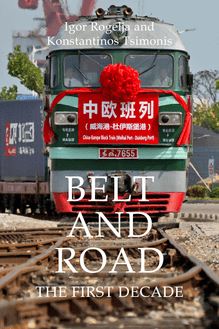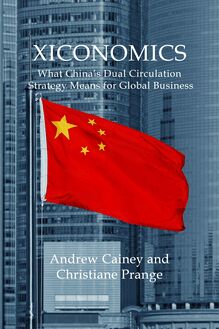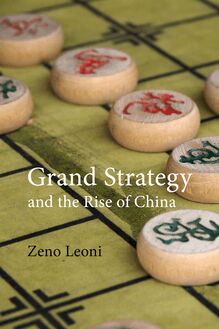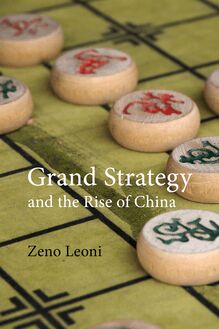-
 Univers
Univers
-
 Ebooks
Ebooks
-
 Livres audio
Livres audio
-
 Presse
Presse
-
 Podcasts
Podcasts
-
 BD
BD
-
 Documents
Documents
-
- Cours
- Révisions
- Ressources pédagogiques
- Sciences de l’éducation
- Manuels scolaires
- Langues
- Travaux de classe
- Annales de BEP
- Etudes supérieures
- Maternelle et primaire
- Fiches de lecture
- Orientation scolaire
- Méthodologie
- Corrigés de devoir
- Annales d’examens et concours
- Annales du bac
- Annales du brevet
- Rapports de stage
La lecture à portée de main
Vous pourrez modifier la taille du texte de cet ouvrage
Découvre YouScribe en t'inscrivant gratuitement
Je m'inscrisDécouvre YouScribe en t'inscrivant gratuitement
Je m'inscrisEn savoir plus
Vous pourrez modifier la taille du texte de cet ouvrage
En savoir plus

Description
The Belt and Road Initiative (BRI) is one of the most talked about yet little understood policy initiatives of the People’s Republic of China. This book offers a comprehensive, balanced and policy-oriented assessment of the BRI’s first ten years and what it has meant for the world’s businesses, polities and societies. The authors explore China’s role as a globally significant source of development finance and investment capital, and examine the political, economic, normative, environmental and social implications of its increased presence in the world.
Aimed at researchers and academics, business professionals and policy analysts, as well as informed readers, the book seeks to answer some of the most pressing questions that China’s rising economic presence in global markets poses: how is the BRI organized? Is it China’s grand strategy? Is it green, is it corrupt, and what are its social effects? Is there even a future for the BRI in a world beset by new uncertainties? The book offers a sober analysis of the most prevalent narratives that cast China as a "threat" and as an "opportunity" and considers the specific challenges that it presents for the liberal international order.
1. What is this book about?
2. How is the BRI organized?
3. Is it China's grand strategy?
4. Is it green?
5. Is it corrupt by design?
6. Is it socially responsible?
Conclusion: Is there a future for the BRI?
Sujets
Informations
| Publié par | Agenda Publishing |
| Date de parution | 15 décembre 2022 |
| Nombre de lectures | 2 |
| EAN13 | 9781788215626 |
| Langue | English |
Informations légales : prix de location à la page 0,1500€. Cette information est donnée uniquement à titre indicatif conformément à la législation en vigueur.
Extrait
BELT AND ROAD
Business with China
Series Editor: Kerry Brown
The titles in this series explore the complex relationship between Chinese society and China’s global economic role. Exploring a wide range of issues, the series challenges the view of a country enclosed in on itself and shows how the decisions made by Chinese consumers, the economic and political choices made by its government and the fiscal policies followed by its bankers are impacting on the rest of the world.
Published
Belt and Road: The First Decade
Igor Rogelja and Konstantinos Tsimonis
China’s Hong Kong: The Politics of a Global City
Tim Summers
The Future of UK–China Relations: The Search for a New Model
Kerry Brown
BELT AND ROAD
The First Decade
Igor Rogelja and Konstantinos Tsimonis
To Silas, Daphne & Lydia
© Igor Rogelja and Konstantinos Tsimonis 2023
This book is copyright under the Berne Convention.
No reproduction without permission.
All rights reserved.
First published in 2023 by Agenda Publishing
Agenda Publishing Limited
The Core
Bath Lane
Newcastle Helix
Newcastle upon Tyne
NE4 5TF
www.agendapub.com
ISBN 978-1-78821-253-3 (hardcover)
ISBN 978-1-78821-254-0 (paperback)
British Library Cataloguing-in-Publication Data
A catalogue record for this book is available from the British Library
Typeset by Newgen Publishing UK
Printed and bound in the UK by 4edge Limited
Contents
Acknowledgements
Acronyms and abbreviations
1. What is this book about?
2. How is the BRI organized?
3. Is it China’s grand strategy?
4. Is it green?
5. Is it corrupt by design?
6. Is it socially responsible?
Conclusion: is there a future for the BRI?
References
Index
Acknowledgements
We wrote this book during a time of heightened polarization of the public debate on China in Europe. The free and stimulating intellectual environments of the European and International Social and Political Studies Department at University College London and of the Lau China Institute at King’s College London, where we are respectively based, allowed us to reflect on the Belt and Road and shielded us from the pressure of having to pick a side as “pro-” or “anti-” China advocates. Scholarly work is relevant to policymakers but we must resist the temptation of adjusting our approach to sound more relevant or in tune with the geopolitical zeitgeist. After extensive politicking in the second half of the last decade, we are glad to witness more balanced and cool-headed narratives on China emerging again. We hope that this book contributes to such an informed debate on the Belt and Road and its many challenges and opportunities.
The first round of thanks begins with Professor Kerry Brown, who pitched the idea of this book to us a few years ago. Throughout the writing process, he has provided comments and feedback that have helped us revisit and sharpen our arguments. We are grateful for his support, encouragement and academic example. Our decision to work on global China was inspired by the scholarship of Professor Julia Strauss, our former PhD supervisor, who was one of the early researchers of Chinese investments in Latin America and Africa. We are also very grateful for the critical comments and valuable suggestions by the anonymous peer reviewers. Their constructive feedback and criticism helped us substantially improve the proposal and the final manuscript.
This book was in many ways formed through collaborations and conversations we had with colleagues and peers. It is impossible to thank everyone but we would like to mention Ben Barratt, Martina Bofulin, Megan Bowman, Anastasia Frantzeskaki, Zeng Jinghan, Jan Knoerich, Evangelos Raftopoulos and Richard Turcsányi for their insights and advice, not to mention their work and scholarly example.
The book benefited greatly from two grants that we received from the King’s Together Fund and the BA/Leverhulme Small Research Grants scheme, which have facilitated our own work on the Belt and Road in Europe and the Balkans. We are grateful to the research support team of the School of Global Affairs at King’s, especially Lyanne Wylde and James Gagen, for helping us to navigate through the complex processes of applying for and spending those grants.
Alison Howson and the team at Agenda Publishing provided excellent support during all stages of writing and publication. Special thanks go to Anca Crowe, Hai Jiawei and Ivan Butler for their assistance in helping us put together a presentable manuscript. Of course, all remaining errors remain our own.
Last but not least, we recognize that academics can be difficult family members, especially when they are working towards book submission deadlines. Silas, Daphne and Lydia have been a constant source of joy and inspiration. We dedicate this book to them as a small token of our gratitude and affection.
Acronyms and abbreviations AIIB Asian Infrastructure Investment Bank ASEAN Association of Southeast Asian Nations BHRRC Business & Human Rights Resource Centre BRI Belt and Road Initiative CCP Chinese Communist Party CDB China Development Bank CEEC Cooperation between China and Central and Eastern European Countries CHEG China Harbour Engineering Group COSCO China Ocean Shipping Company CPEC China–Pakistan Economic Corridor CRBC China Road and Bridge Corporation CSR corporate social responsibility EIA Environmental Impact Assessment EU European Union FDI foreign direct investment FIC Forum for International Cooperation FOCAC Forum on China–Africa Cooperation GDI Global Development Initiative GDP gross domestic product GWD Great Western Development ICBC Industrial and Commercial Bank of China IMF International Monetary Fund LRT light rail transit LSG leading small group MDB multilateral development bank MFA Ministry of Foreign Affairs MOFCOM Ministry of Commerce of the People’s Republic of China MoU memorandum of understanding NATO North Atlantic Treaty Organization NDRC National Development and Reform Commission NGO non-governmental organization OECD Organisation for Economic Co-operation and Development OEEC Organisation for European Economic Cooperation PCT Piraeus Container Terminal PH Pakatan Harapan PLA People’s Liberation Army PPA Piraeus Port Authority PRC People’s Republic of China PSC private security company SASAC State-owned Assets Supervision and Administration Commission SCO Shanghai Cooperation Organization SEZ special economic zone SGR standard-gauge railway SOE state-owned enterprise TEAS Tebian Electric Apparatus Stock Co. Ltd TEU twenty-foot equivalent unit UN United Nations UNODC United Nations Office on Drugs and Crime WGI World Bank’s World Governance Indicators WTO World Trade Organization
1
_____________________________
What is this book about?
After years of struggling under austerity imposed by European partners and a chilly shoulder from the United States, Greece has embraced the advances of China, its most ardent and geopolitically ambitious suitor … While Europe was busy squeezing Greece, the Chinese swooped in with bucket-loads of investments that have begun to pay off, not only economically but also by apparently giving China a political foothold in Greece, and by extension, in Europe.
Horowitz and Alderman ( 2017 )
In Greece, China has used its checkbook to take the port of Piraeus, … accomplishing what the Persian King Xerxes failed to do with overwhelming force twenty-five hundred years ago.
Hillman ( 2020 : 23)
A train of thought that presents China’s global economic activities as an attempt at political domination has become commonplace over the last decade. Books, journal articles, policy reports and political speeches from around the world began to warn of China’s new-found assertiveness. At the same time, Xi Jinping suddenly seemed eager to loudly proclaim his ambitions and emerge from the sidelines of global politics. Take the examples above, which suggest China used economic power as a way to acquire a political foothold in Greece (where even Xerxes failed, no less). What motives might the authors be suggesting? To what ends will this “political foothold” be used? Will China build a new Sinocentric world order? Will it push out the US and the West, one country at a time? Will it write the last chapter of its long revenge for the century of humiliation? This appealing argument has captured public imagination about the Belt and Road Initiative (BRI, the Initiative, sometimes called “OBOR” due to its Mandarin name yi dai yi lu 一带一路, literally “One Belt One Road”). However, there are four main problems with the logic behind this perception that prompted us to write this book at the end of the BRI’s first decade.
The first issue is that this narrative is self-perpetuating and addictive. If we start off believing that Chinese activities are part of an imperialist plan to dominate the world, we can easily pile up evidence that this is happening simply by reframing all economic deals, loans, trade agreements and new infrastructure projects as shrewd moves on a global chessboard. This is because the alleged motive – global hegemony – is so vague that it allows us to reframe everything that China does as evidence, even dispatching Covid-19 humanitarian aid. The repetitive framing of the activities of Chinese companies as a potential or actual threat to the present world order ultimately becomes addictive, tempting us to interpret all developments through this lens and to create narratives embellished with stereotypes and alarmist language, often using military terms and expressions. As the opening paragraph for this book attests, “threat speech” can easily make its way into any narrative.
The second problem is that the “global domination” logic fails to appreciate nuance. Reading some of the more alarmist literature, you would be forgiven thinking that the decision-making process of the Belt and Road is like the war room in Stanley Kubrick’s Dr Strangelove . In this vision, depicted in elaborate maps wit
-
 Univers
Univers
-
 Ebooks
Ebooks
-
 Livres audio
Livres audio
-
 Presse
Presse
-
 Podcasts
Podcasts
-
 BD
BD
-
 Documents
Documents
-
Jeunesse
-
Littérature
-
Ressources professionnelles
-
Santé et bien-être
-
Savoirs
-
Education
-
Loisirs et hobbies
-
Art, musique et cinéma
-
Actualité et débat de société
-
Jeunesse
-
Littérature
-
Ressources professionnelles
-
Santé et bien-être
-
Savoirs
-
Education
-
Loisirs et hobbies
-
Art, musique et cinéma
-
Actualité et débat de société
-
Actualités
-
Lifestyle
-
Presse jeunesse
-
Presse professionnelle
-
Pratique
-
Presse sportive
-
Presse internationale
-
Culture & Médias
-
Action et Aventures
-
Science-fiction et Fantasy
-
Société
-
Jeunesse
-
Littérature
-
Ressources professionnelles
-
Santé et bien-être
-
Savoirs
-
Education
-
Loisirs et hobbies
-
Art, musique et cinéma
-
Actualité et débat de société
- Cours
- Révisions
- Ressources pédagogiques
- Sciences de l’éducation
- Manuels scolaires
- Langues
- Travaux de classe
- Annales de BEP
- Etudes supérieures
- Maternelle et primaire
- Fiches de lecture
- Orientation scolaire
- Méthodologie
- Corrigés de devoir
- Annales d’examens et concours
- Annales du bac
- Annales du brevet
- Rapports de stage









